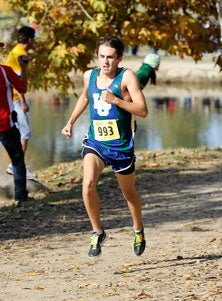In his career, Steve Scott ran a record 136 sub-4 minute miles. Chances are, no one will ever break that mark and the former American record-holder said that's one of the reasons track is dying world-wide.
"People can relate to a sub-4 minute mile," said Scott, now the track and cross country coach at Cal State San Marcos, 30 miles north of San Diego. "Most people have no idea what a really fast 100-meter time is and the pole vault, they just don't know a good mark.
"But the mile, everyone knows."
Scott says to bring life back into track and field in this country and worldwide, the mile should be reintroduced, starting at the high school level where in the history of the event, only five runners have ever cracked the magical barrier before starting college.

Darren Fahy, La Costa Canyon
Photo by Miranda Chrislock
Darren Fahy of
La Costa Canyon (Carlsbad, Calif.), who currently owns the third-fastest 1,600 mark this season, and his coach, Bill Vice, agree.
"Earlier this year we had a mile run at a dual meet and called it 'Bring back the mile,'" explained Vice. "Steve (Scott) was the starter. It had been 30 years since he set the American record and everyone had a good time.
"The thing is, most people think in terms of the mile. I have a daughter (Morgan) in the seventh grade and she thought she was running a mile until recently, not 1,600 meters. It's magical, it means something."
The difference between the two? The mile is about 9.3 meters longer than the 1,600.
Vice remembers being around in the 1970s when the country made a concerted effort to go metric. Signs had miles and kilometers, ballparks had the distance to the fences in metric and feet. Track bought into it and quickly, especially as tracks were converted to all-weather 400-meter facilities, meets offering the mile all but disappeared.
The mile is now a specialty event, run maybe four times a year at high school invitational meets and even less internationally.
Now, distance signs are back to only miles, ballparks have erased the meter readings and all but track have abandoned the change.
Vice said running a mile presented absolutely no logistical problems and that was evident at the recent Arcadia Invitational. A piece of tape nine yards back of the 400-meter starting line or, as Vice did, a little chalk, and voila — a mile run.
So why not change?
"People are lazy," said Vice. "I didn't hear a single objection at our meet or Arcadia. Kids think they are running a mile anyway."
Fahy said while he doesn't care if it's a 1,500, a 1,600 or a mile, when people ask him what his time was in a meet, they call the event the mile.
"I can't tell the difference because I'm just running to the finish line," said the Georgetown-bound senior whose 1,600-meter time of 4:08.15 generally converts to a 4:09.55 mile. "But I know I'm still No. 1 in the 1,600 but only No. 3 in the mile.
"I just wish they'd take a distance and agree on it. Yes, it's easier to break 4 minutes in a 1,600, but it's not the mile."
Scott, who said the only way he could break 4 minutes in the mile now is "if someone throws me off a cliff," has a ready answer to why his 136 sub-4s between 1977 and 1994 will probably never be broken unless there is a change.
"My first sub-4 was in an indoor race where I finished third," he explained. "When I heard my time, I thought ‘That was easy.' I couldn't wear spikes because the bank of the indoor track was too steep and it came as a shock.
"Back then you could run 8 to10 indoor miles and 4 to 5 outdoors. Now I'll bet there aren't five opportunities."
But even though he has become the most prolific miler in history, he still isn't on the high school sub-4 miler list that includes Jim Ryun (five times with a best of 3:55.3 in 1965), Alan Webb (the record 3:53.43 in 2001), Tim Danielson (3:59.4 in 1966), Marty Liquori (3:59.8 in 1967) and most recently Lukas Verzbicas (3:59.71 in 2011).
"In high school (Upland, Calif.) I ran the 880 and it wasn't until my junior year at UC Irvine that I broke 4 minutes," said Scott. "What makes the race difficult is lots of people can run 4:02, it's the last two to three seconds that is tough."
So, how was he able to run so many sub-4s?
"Besides opportunity, the crowds would go crazy whenever you ran a mile because everyone could relate to a sub-4," said Scott, whose CSSM women's cross country teams have won three straight NAIA titles and his men finished second last season.
"You had to run fast to win because meet promoters would get good fields."
Vice said the only hope of returning the mile to its lofty position is for a groundswell of action.
"I'll lead the crusade if that's what it takes," said Vice. "It's just not that difficult to run a mile instead of 1,600. It would simplify things and none of the other events need to be changed. This comes up every year when we get milers under 4:10 and they don't have many chances in big meets.
"Return the mile on the national high school level and I believe track and field would regain a lot of the interest it has lost."
